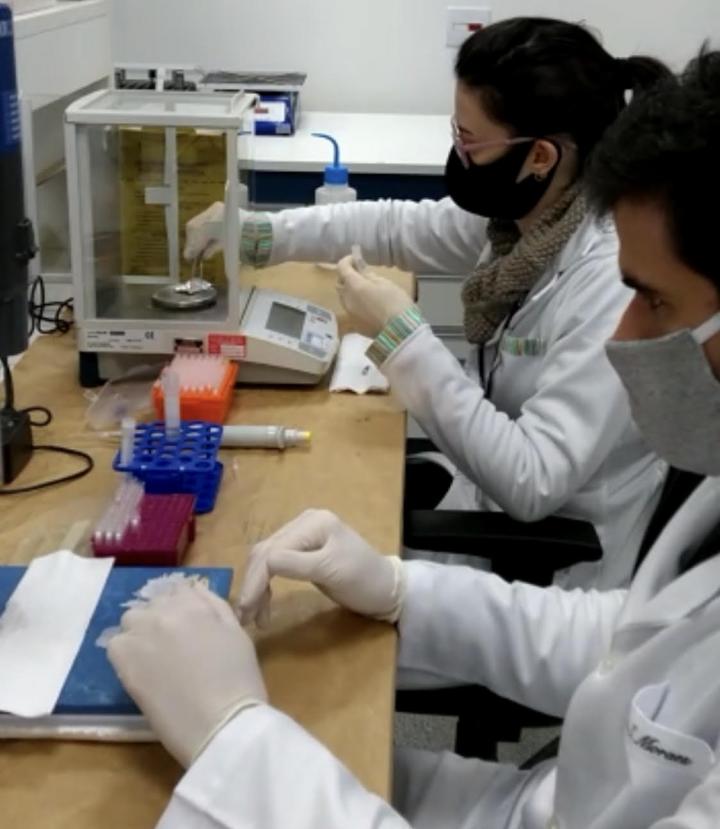Brazilian researchers observed that in uninfected adipocytes, the hormone irisin altered the expression of genes that regulate ACE-2, which encodes a protein to which the virus binds in order to invade human cells.

Credit: Miriane de Oliveira
A study conducted by researchers at São Paulo State University (UNESP) suggests that irisin, a hormone secreted from muscles in response to exercise, could have a therapeutic effect on COVID-19 patients. When they analyzed adipose cell gene expression, the researchers found that irisin modulated genes associated with replication of the novel coronavirus SARS-CoV-2 in human cells.
This finding was based on analysis of the transcriptome (all RNAs produced by genes) of adipose cells not infected by SARS-CoV-2 and treated with irisin. “We compared data for genes important in COVID-19 with our transcriptomic data to make correlations. The results offer a clue in the search for treatment of the disease during the emergency caused by the pandemic. It must be stressed that our findings are preliminary and merely suggest that irisin could have therapeutic potential in cases of COVID-19. Further research can pick up from here to see whether irisin’s effects on patients with the disease are indeed beneficial,” Miriane de Oliveira, a researcher at UNESP’s Medical School in Botucatu, São Paulo (Brazil), told Agência FAPESP.
An article describing the study is published in the journal Molecular and Cellular Endocrinology. The data were produced by Oliveira in postdoctoral research supported by FAPESP and focusing on the action of irisin and thyroid hormones in adipocytes.
The use of sequencing techniques enabled the researchers to identify 14,857 genes expressed in a subcutaneous adipose cell line. They observed alterations in gene expression when cells were treated with irisin.
Because of the pandemic, researchers decided to investigate the possible effects of irisin on genes associated with the replication of SARS-CoV-2. From data cross-tabulation, they discovered that treatment of adipocytes with irisin reduced expression of the genes TLR3, HAT1, HDAC2, KDM5B, SIRT1, RAB1A, FURIN and ADAM10, which in turn regulate ACE-2, a key gene for viral replication because it encodes the protein to which the novel coronavirus binds in order to invade human cells.
Another positive finding was that irisin tripled levels of transcription of the gene TRIB3. Previous research has demonstrated the importance of maintaining expression of TRIB3. In fact, expression of TRIB3 is frequently diminished in older people, a factor that may be linked to augmented replication of SARS-CoV-2 and a higher risk of COVID-19 in this segment of the population.
“A third important point is the finding by other research groups that adipose tissue appears to serve as a repository for the virus,” Oliveira said. “This helps explain the higher risk of developing severe forms of the disease for individuals with obesity. In addition, obese people tend to have lower levels of irisin and higher levels of the receptor molecule used by the virus [ACE-2] than nonobese people” (read more at: agencia.fapesp.br/33729).
Produced endogenously during continuous exercise, irisin is known to be involved in the browning of adipose tissue. White fat stores energy in the form of triglycerides and lipids and can become inflamed. Brown fat breaks down blood sugar and fat molecules to create heat and help maintain body temperature. Thus, irisin is part of a calorie-burning process that can help treat metabolic disorders such as obesity. It is also known to modulate the activity of macrophages, which are immune cells that can release cytokines and trigger inflammation.
Data management
Oliveira’s study is an example of how managing data obtained in basic research can lay the foundation for other discoveries and research. “We began with a comparative analysis of the action of irisin and thyroid hormones in moderating fat accumulation and modulating genes in adipose cells,” she said. “The study produced a large amount of data, and with the advent of the pandemic and the discovery by other research groups of genes associated with replication of SARS-CoV-2, we decided to use our database to investigate how irisin [and thyroid hormones] may influence the disease.”
The original investigation set out to discover how these hormones perform their thermogenic role in reducing adipose tissue and generating energy in adipocytes. “We did this by means of transcriptomics to identify the genes affected by the hormones in question, and our findings served as a basis for the study relating to COVID-19,” Oliveira said.
This study showed that irisin not only moderates fat accumulation but also stimulates the expression of uncoupling protein 1 (UCP1), releasing heat and reducing fat deposits. Increased levels of UCP1 are compatible with decreased DNA damage and oxidative stress.
With this better understanding of the role played by irisin in obesity and possibly in COVID-19, the research group will now analyze its effect on cells infected with SARS-CoV-2. The principal investigator for this project is also Célia Regina Nogueira de Camargo, a professor in the Clinical Medicine Department of UNESP’s Botucatu Medical School. The project is supported by the Ministry of Education’s Coordination for the Improvement of Higher Education Personel (CAPES).
“The aim is to take another step in this line of research and determine whether the results obtained in our bioinformatics investigation can be confirmed in a three-dimensional adipose cell culture model,” Oliveira said. “We want to understand how irisin modulates the genes associated with SARS-CoV-2 replication.”
The article “Irisin modulates genes associated with severe coronavirus disease (COVID-19) outcome in human subcutaneous adipocyte cell culture” (doi: 10.1016/j.mce.2020.110917) by Miriane de Oliveira, Maria Teresa De Sibio, Lucas Solla Mathias, Bruna Moretto Rodrigues, Marna Eliana Sakalem and Célia Regina Nogueira can be retrieved from www.sciencedirect.com/science/article/pii/S0303720720302173.
Media Contact
Heloisa Reinert
[email protected]
Original Source
https:/
Related Journal Article
http://dx.




